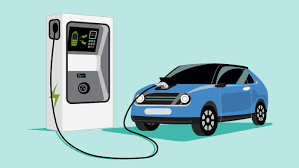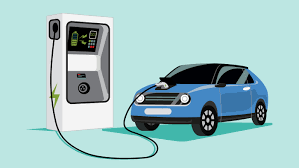Policies and Solutions to Mitigate Electric Vehicle Adoption in Developing Countries.
Electric cars have gained significant attention worldwide as a promising solution to combat climate change and reduce greenhouse gas emissions. In contrast, developed countries have been at the forefront of adopting electric vehicles (EVs).


Electric cars have gained significant attention worldwide as a promising solution to combat climate change and reduce greenhouse gas emissions. In contrast, developed countries have been at the forefront of adopting electric vehicles (EVs).
Transport accounts for 20 % of greenhouse emissions, and transit to electric vehicles promises decarbonization and clean transport in the future. However, the exponential rise of electric vehicles (EVs), expected to reach 240 million by 2030, poses technical challenges for power systems, particularly in developing countries. Lack of sufficient power grids in these regions may cause a delay in adoption.
As we struggle to transition to electric vehicles, electric utilities are crucial in transitioning to green, clean, and more sustainable transportation systems. As the demand for EVs grows, utilities must prepare. There is a need for increased distribution in their infrastructure to ensure the power can meet the increased demand and use new grid resources.
Read: More EVs in Kenya despite lack of policy support.
With all the challenges there come opportunities. Electric utilities can benefit from the growth of E-Mobility by exploring charging opportunities in the market and promoting the adoption of EVs. For example, utilities can partner with governments and county governments to install public charging stations or offer incentives for EV ownership. By doing so, utilities can increase revenue, attract new customers, and improve customer satisfaction. Planning is critical, and utilities should evaluate the least-cost way to meet the demand while maintaining reliability and security. Utilities can also explore the use of smart grid technologies to help manage the increased demand for electricity from EVs while improving system efficiency and reducing costs.
Challenges of Introducing Electric Cars in Developing Countries.
- Infrastructure Challenges. One of the primary obstacles facing the introduction of electric cars in developing countries is the lack of adequate charging infrastructure. Establishing a robust network of charging stations requires substantial investments and meticulous planning. Many developing nations currently lack the necessary infrastructure, making it difficult for EV owners to find convenient charging points. Additionally, limited access to reliable electricity in some regions poses a significant challenge for widespread adoption.
- Affordability and Accessibility. High upfront costs associated with electric vehicles present a barrier to their adoption in developing countries. The price of EVs, including batteries, remains relatively high compared to traditional combustion engine vehicles. This affordability gap makes it challenging for a large portion of the population to purchase electric cars. Moreover, the availability of affordable EV models in developing nations is limited, as manufacturers often prioritize developed markets due to higher demand.
- Technology and Skill Gap. Developing countries may face technological challenges in the production and maintenance of electric cars. The production of EVs requires advanced technology and expertise, which may be lacking in some regions. Training a skilled workforce for EV maintenance and repair is crucial to ensure the long-term viability of electric cars. Capacity building and technology transfer initiatives can play a vital role in bridging this gap.
See: Electric Vehicles, Climate change, and global health policy
Addressing the Challenges and Maximizing Opportunities
To realize the full potential of electric cars in developing countries, concerted efforts are required:
- Government Initiatives and Policies. Governments should establish supportive regulatory frameworks and implement policies that incentivize EV adoption and manufacturing. Financial incentives such as tax breaks, subsidies, and reduced import duties can make electric cars more affordable for consumers. Investments in charging infrastructure, particularly in urban areas and along major highways, are crucial to ensure convenient access to charging stations. Governments should also prioritize the integration of renewable energy sources to power EVs.
- International Cooperation and Partnerships. Collaboration with developed countries can facilitate technology transfer and knowledge sharing. International organizations and bilateral partnerships can provide financial assistance, technical expertise, and capacity-building programs to support developing nations in overcoming challenges. Sharing best practices and successful case studies from developed countries can expedite the adoption of electric cars in developing nations.
- Public Awareness and Education. Raising public awareness about the benefits of electric cars is vital to drive consumer demand. Governments, in collaboration with stakeholders, should launch campaigns to educate the public about EV charging infrastructure, maintenance requirements, and the long-term cost savings associated with electric cars. Furthermore, promoting sustainable transportation behaviors, such as carpooling and the use of public transit, can complement the adoption of electric vehicles.
Opportunities for Electric Cars in Developing Countries.
- Environmental Benefits. The adoption of electric cars in developing nations can significantly contribute to environmental sustainability. By replacing conventional fossil fuel vehicles, electric cars can reduce greenhouse gas emissions and mitigate air pollution. Improved air quality leads to better public health outcomes, reducing the burden on healthcare systems. Furthermore, electric cars align with global efforts to preserve natural resources and combat climate change.
- Energy Security and Independence. Developing countries often rely on imported fossil fuels, exposing them to price fluctuations and geopolitical risks. Introducing electric cars enhances energy security and independence. By integrating renewable energy generation with EV charging infrastructure, developing nations can reduce their dependence on imported fuels and harness their clean energy resources.
- Job Creation and Economic Growth. The widespread adoption of electric cars presents an opportunity for developing countries to stimulate economic growth and create new employment opportunities. Establishing domestic EV manufacturing and assembly industries can generate jobs across the value chain, from raw material sourcing to vehicle production. Additionally, the development of a new supply chain for EV components can foster local industries and increase competitiveness in the global market. Skilled jobs in EV maintenance and servicing can also be created, boosting employment prospects.
- Sustainable Urban Mobility. Rapid urbanization in developing nations has led to increased traffic congestion, air pollution, and noise levels. Electric cars offer a sustainable solution for urban mobility. By promoting the use of electric buses for public transportation and supporting the adoption of electric two-wheelers for short-distance travel, developing countries can alleviate traffic congestion, reduce noise pollution, and improve the overall quality of life in cities.
Related: Electric Motorbikes hit the Kenyan market.
Solutions to mitigate impacts
We have researched some of the solutions to help mitigate EV adoption. Here are some of them below:
i) Smart charging strategies.
These smart charging strategies can help reduce negative impacts while using the potential benefits of vehicle-grid integration (VGI). These strategies aim to help shift the load to the most optimal time from the system operator's perspective, while also respecting the EV owner's preferences and considering power system constraints.
ii) Battery swapping systems.
Battery swapping systems are gaining popularity in markets with a high percentage of two and three-wheel EVs. For example, in India, the swapping market will have a cumulative average growth rate of 31.3% from 2020 to 2030. Also, in Kenya, more startup companies such as Roam have put up swap stations on major highways, busy malls, and gas stations. The battery swapping stations allow for the quick replacement of discharged batteries with fully charged units, reducing the burden on the power grid during peak demand periods and facilitating renewable energy integration.
Read: Electric vehicles can help reverse Climate Change.
iii) Strategic placement of charging infrastructure.
Setting charging stations in strategic locations will help reduce charge anxiety. Equally, strategic placement of charging infrastructure in areas with ample grid hosting capacity can minimize the need for grid reinforcements. On-site solar generation and battery storage facilities can also increase flexibility and mitigate negative impacts. Standards and interoperability requirements can further improve grid safety and facilitate aggregation.
iv) Reducing EV energy consumption.
This can be done through more efficient cooling systems, which can also help to mitigate technical impacts. An ESMAP-funded study in the Middle East and North Africa has shown that optimizing mobility cooling can save between 7 percent and 30 percent of the electricity consumed by EVs in the region, extending driving range and reducing charging demand.
Source:
i) cyber switching (2023) Electric Cars in Developing Countries: Exploring the challenges and opportunities of introducing electric cars in developing nations and the potential impact on economic growth and sustainability.




